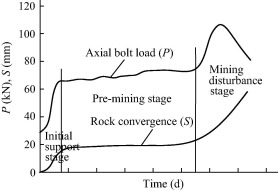
Privacy statement: Your privacy is very important to Us. Our company promises not to disclose your personal information to any external company with out your explicit permission.
In consideration of the coal industry standard in China: `Bolt support technical specifications` (MT/T 1104-2009) , the analysis of the characteristics of pre-tensioned and end-anchored bolts and the problems of in-situ bolt support quality indicates that the detection parameters of single bolt support quality include two main aspects. One is the full-length and anchorage length of bolts; the other is the real-time axial load of bolts . For a newly-installed bolt, the parameters to be detected are the full-length and anchorage length, because they determine the supporting horizon and the stability of the bolt support structure. Simultaneously, the bolt pre-tension is examined to determine if it meets the designed values. After bolt installation, the main task is to monitor the change in magnitude of the axial bolt load in real time at different mining service stages. The monitoring of axial bolt load can evaluate whether or not the bolt support is in good working condition.
Roadways in coal mining districts, from development to abandonment, will go through three service stages according to different mining methods, i.e., initial support stage, pre-mining stage and mining disturbance stage. Through the analysis on the existing results of bolt load evolution in deep roadways and many in situ testing results, the working status characteristics of bolts in the roadways of mining districts at different mining service stages are shown in Fig.2.
Generally speaking, a comparatively large tightening torque (usually 200–400 Nm) is exerted on the bolt head in order that the newly installed bolt can provide great pre-tension (usually 20–50 kN) in time after the roadway is dug. According to field researches, the yield load (Ps) of most of the bolts in deep roadways is designed to be about 150 kN. This indicates that the pre-tension of newly installed bolts in deep roadways is better to be set as 30% of the yield load so that the bolts can support more actively in time.
Within 3–5 days after the installation of bolts or 25 m of roadway excavation, the surrounding rock contracts inward rapidly, thus causing a sharp increase in axial bolt load. During this stage, the axial bolt load increases rapidly to 50–70 kN, a rise of approximately 20–30 kN.
When the roadway is dug over 25 m, the contraction of the surrounding rock tends to be stable with slight adjustments. At this stage, which is also called the pre-mining stage, the deformation rate is much lower than that in the initial support stage. The axial bolt load fluctuates but exhibits an overall rising trend. The axial bolt load finally remains at about 50% of its yield load (Ps). When the roadway is dug over 50 m, the surrounding rock deformation is almost immune to the excavation influence.
During the mining stage, stresses build up in the surrounding rock of the working face.Abutment pressure appears in front of the working face, and the mining influence range is about 20–30 m. In the mining influence zone, the axial bolt load increases to about 80–120 kN, namely within 80% of the yield load. But in the case of complex geological conditions, rare cases also appear where the axial bolt load reaches or even exceeds the yield load, which leads to the bolt tray splitting or bolt fracture. When the abutment pressure caused by mining increases, or even exceeds the maximum bearing capacity of surrounding rock closely adjacent to the working face, the coal and rock fails and then releases the pressure. The axial bolt load in turn increases to its maximum value and then decreases. The change in axial bolt load is determined by the front abutment pressure and great correlation can be detected between them. Zones far away from the working face are less influenced by mining and the deformation of surrounding rock in the zones to be mined remains relatively stable.
In summary, there exists a good correspondence between real-time axial bolt load and the entire process of deformation, failure, and destruction of roadways in mining districts. The monitoring results of real-time axial bolt load can be used to evaluate and judge the stability of the surrounding rock. Some project cases are examined in the following section to demonstrate the pre-warning indexes of axial bolt load and illustrate the pre-warning technology of surrounding rock stability.
According to the change rules of axial bolt load in different service stages in Fig.2, the detection of axial bolt load in the initial support stage can provide good reference for the evaluation of roadway support strength; meanwhile it is of great benefit to promptly adjust the support parameters or even the support scheme and troubleshoot the potential safety hazards in bolt support. Therefore, it is necessary to detect and evaluate the pre-tension and axial load variation of bolts in the initial support stage. In the following, three typical project cases are presented to demonstrate the variation characteristics of axial bolt loads in the initial support stage. One case represents insufficient bolt pre-tension, another shows much too large initial anchorage force and the third one exhibits rapid growth of axial bolt loads in the initial support stage. Through the analysis of these projects, the pre-warning index for axial bolt loads in the initial support stage is proposed.
LET'S GET IN TOUCH

Privacy statement: Your privacy is very important to Us. Our company promises not to disclose your personal information to any external company with out your explicit permission.

Fill in more information so that we can get in touch with you faster
Privacy statement: Your privacy is very important to Us. Our company promises not to disclose your personal information to any external company with out your explicit permission.